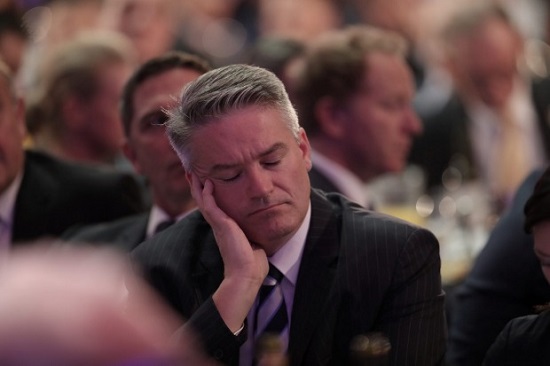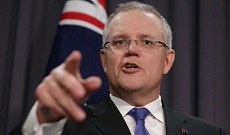There was a story around that Mark Textor had a hand in the creation of the 2017 budget. Joe Aston in the AFR says Forget Mark Textor, JWS’ John Scales was the Treasurer’s budget pollster. Aston says that Scales, who was a protégé of Textor’s did the real work, or at least his company JWS Research.
However, Textor did play an important role. The Daily Telegraph reported back in early April that Textor’s research (for the Liberal Party) “highlighted the critical issue of housing affordability”, following which, ScoMo proposed changes to negative gearing that were shot down immediately by Mathias Cormann and Peter Dutton.
This little frolic by ScoMo caused Turnbull to take a greater interest in the budget deliberations, and with the help of Cormann, rein him in. The paltry $30,000 in pre-tax super contributions towards a house deposit was purely cosmetic.
A shame, really, because I think paying for a roof over our heads is sucking the life out of consumption to the detriment of the economy.
On April 20 the Commonwealth government:
- disclosed a $213,400 contract for market research awarded to JWS. The job began on March 15. That gig (the fee for which is, ironically, equivalent to a decent house deposit) was supplementary to a $403,150 contract JWS already had with Treasury, beginning back in December and the $274,670 Josh Frydenberg’s Environment and Energy Department is paying JWS for research that began in February.
Aston says there is no public record of Textor having provided any consulting services to the Commonwealth government in recent years.
Meanwhile The Australian published a story that the $6.2 billion banking levy “was ScoMo’s revenge” because “it had recently become personal” after the Australian Bankers’ Association passed over his press secretary Sasha Grebe to hire former Queensland Labor premier Anna Bligh as its new CEO.
That story was a good one, but it only lasted a day, when The Australian revealed exclusively that the scheme was hatched in January, when ScoMo visited the Britain’s Financial Conduct Authority. That was a full month before Bligh was appointed.
Here’s poor Matthias, tired out from all the work he had to do for the country:

Actually he is listening to ScoMo’s rivetting delivery at the National Press Club.
Peter Lewis says that back in April Essential Report found (LNP-Labor figures in brackets) that the LNP was Too close to the big corporate and financial interests (71-40), Divided (68-49), Out of touch with ordinary people (68-50), and Will promise to do anything to win votes (71-63). Labor also scored quite well in that last category.
Lewis says that when the Turnbull government secured a deal to cut the corporate tax rate for companies earning up to $50m, The Australian lauded the deal as a “grand tax bargain”. Strategically it looks more like an own goal than a home run, to mix sports metaphors.
- As the centrepiece of the government’s trickledown economics agenda, the tax cuts have been ushered in at a time of flat-lining wages, cuts to penalty rates and a heightened debate over the minimum wage.
The government’s partial success on company tax cuts has two immediate consequences. First, it plays into the storyline that it is putting the interests of businesses ahead of working people. Second, it ensures the issue of cuts to larger companies remain at the centre of the policy context.
Labor scored better, in ascending order of difference, on Clear about what they stand for, Have a vision for the future, Trustworthy, Has a good team of leaders, Moderate, Keeps its promises, Understands the problems facing Australia, Have good policies, and Looks after the interests of working people.
In the post-budget poll Essential found when they asked In general, who do you think the federal budget will be good or bad for? the answers reflected the view of the Coalition back in April. When fed the line, This budget is more about improving the Government’s popularity than improving the economy respondents agreed 51-27. In response to This budget favours businesses over workers they agreed 48-28.
Nevertheless Labor was not showered with love. In the Approval rating of leaders, Turnbull on 37% and Shorten on 34% both fall well short of Donald Trump.
When asked who they would trust most to handle Australia’s economy – Scott Morrison or Chris Bowen – 26% went for ScoMo, 22% for Bowen and a whopping 52% said they didn’t know.


Brian: There is no sense of a government or opposition that has a clear view of what is happening and what needs to be done about it. For example, we talk about low inflation because the cost of land isn’t part of the calculation. We claim to be supporters of free trade even though there is little evidence that it is improving lives in developed countries.
I could rabbit on but i see no evidence that the government has a clue.
John, I think of the LNP politicians as third-rate at best, and Labor pollies as good second-raters at best.
In today’s Fin Review there’s a story about Geoff Harris, the co-founder Flight Centre, who wants the govt to borrow $200 billion to spend on infrastructure.
He also wants to get rid of states and local councils and organise the place into regions .
We are in the crazy situation at the moment where Brisbane is closer to Launceston than parts of Qld and everything north of about Coffs Harbor is closer to Brisbane. There are also parts of NSW that are closer to Melbourne or Adelaide and treat these non-NSW capitals as the place to go for medical treatment etc.
Perhaps we could start boundary reform by redrawing the boundaries so that they are equidistant from the relevant state capitals. Perhaps adding a new capital somewhere in Northern Qld and Northern WA might help as well.
John, I think the idea would be to start with a clean sheet and look at geography, demography, economic and social interest and transport corridors. When this was considered before, about 20 years ago from memory, there was a notion of about 35 regions in the country.
In Qld, probably Cairns, Townsville, Rockhampton, SEQ and probably the Fraser coast (Bundaberg/Maryborough etc) would be the minimum you’d need.
The Churches did that sort of thing a long time ago called Diocese.
The Cattle Ticks have 33.
What ever their motives they’re pretty good at organising.
I think you’d have to take out the states. For example, I suspect that Armidale looks more to Brisbane than the Sydney, and Tamworth just down the road probably looks to Sydney. But neither of them would want to be governed as an adjunct to a big coastal city.